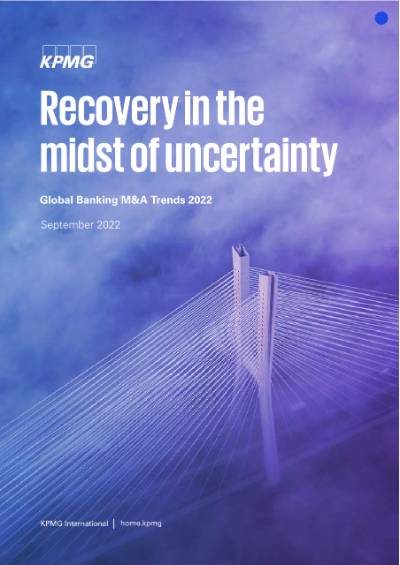As we look towards the balance of 2022 and beyond, several key dynamics, themes and expectations will drive the global banking M&A landscape.
1. Further outbreaks of COVID-19, along with the Ukraine-Russia conflict, has increased macroeconomic uncertainty, impacting bank valuations globally
The war in Ukraine has shaken the foundations of international peace and security system, creating a large humanitarian and economic crisis. It is another blow to a global economy already suffering from COVID-19 and climate change, increasing inflation, disrupting supply chains, and heightening cybersecurity risks.
As of mid-June 2022 North American banks were trading at P/TBV equal to an average of 1.5x, ASPAC banks at 1.3x, and European banks at a significantly discounted average of P/TBV at 0.8x.
Low valuations and profitability should continue to drive consolidation in the European market, as banks look to make deals to gain cost efficiencies and improve market standing.
The Ukraine war continues to increase inflation, disrupt supply chains and heighten cybersecurity risk. European banks have a relatively larger exposure to Russia, increasing their risk from sanctions. Consequently there has been a year-on-year decline in deal volume in 1H22.
2. Seven major themes shaping the banking M&A landscape
Seven major themes are likely to influence global banking M&A for the rest of 2022 and beyond - these may vary by region.
COVID-19 hastened the transition to online banking, while fintech is going mainstream. Advances such as mobile payments, merchant mobile apps, and cryptocurrencies, are hitting banks' revenue streams and forcing investment in digital. Automation is reducing costs, replacing manual processes, offering personalized customer interaction, accelerated KYC and lending decisions and better fraud prevention and loan pricing.
Potential impact
Banks are launching their own digital banks and accessing capabilities through acquisitions and partnerships - which also diversify revenue sources. Italy's Intesa Sanpaolo has announced a digital bank, ISY Bank, to counter fintech competitors, reduce costs, and grow its international retail market. Standard Chartered has invested in digital banking in Hong Kong with plans to roll out regionally - as have other digitally led banks in Singapore like DBS.
We can also expect banks to set up corporate venture funds to invest in technology, while PE and VC have been active in the neo bank sector, with large funding rounds, as featured in our recent Pulse of Fintech report.
With stakeholders demanding sustainable business practices, more than 270 banks worldwide have joined the Principles for Responsible Banking framework. ESG-linked funds, bonds, assets, retail banking and investing products are on the increase, with wealth management arms embracing ESG investing, and capital markets adopting `green underwriting'.
However, many banks still possess significant profit-generating `brown' assets and must balance ESG ambitions against shareholders' desire for strong returns.
Potential impact
In addition to financial viability, future deals will increasingly be viewed through an ESG lens, while banks' asset management units are likely to favor more sustainable companies.
Faced with revenue disruptions, profitability concerns, competition from non-traditional, digital players, rising compliance costs, and tighter cybersecurity, banks are seeking scale efficiencies.
However, many banks still possess significant profit-generating `brown' assets and must balance ESG ambitions against shareholders' desire for strong returns.
Potential impact
Acquiring a bank can open new geographies, increase existing market presence, expand products, services and business lines, acquire technology and talent, and bring cost efficiencies. Deals can also improve funding, by reducing costs and improving profiles. For smaller banks, being acquired can help fund technology spend, overhaul legacy systems and mitigate cyber risk.
PE houses, technology companies, conglomerates and others are competing for bank targets. PEs are either investing in or buying bank assets directly (including underperforming ones). North American PEs are especially interested in European banks, attracted by low valuations and high growth potential. In the US, fintechs are buying small bank charters, over-bidding other banks, while conglomerates, and players from other sectors, are also active in M&A.
However, many banks still possess significant profit-generating `brown' assets and must balance ESG ambitions against shareholders' desire for strong returns.
Potential impact
A widening universe of buyers makes it difficult for traditional banks to acquire targets and grow inorganically and may force them to consider other routes such as partnerships.
Europe
The anticipated pandemic-led NPL surge has not materialized. Continued decline in NPL levels is a result of fiscal and regulatory measures and wider economic recovery, as well as secondary market disposals and government led/backed securitization schemes. Amendments to securitization regulation recognize securitization as a funding tool to facilitate NPL sales.
The combination of declining NPLs and rising Stage 2 loans may foreshadow an NPL increase, with the ratio of Stage 2 loans (for EU) at 9.1 percent for 1Q22 up from 8.9 percent for 4Q21 and 8.7 percent1 in 3Q21. Uncertainties from the Ukraine conflict may drive an increase in NPL volume and bad debt provisions.
ASPAC
To mitigate the COVID-19 impact and keep NPL volumes in check, ASPAC central banks have been generous with forbearance measures. As payment moratoriums phase out, the real impact on loan portfolios will become clearer. Certain economies have established NPL markets that facilitate and allow trade in distressed assets, but others lack such platforms due to legal and institutional shortcomings.
Potential impact
European banks are likely to continue to dispose of NPLs, to reduce exposure. As global investors shift to Asia, there is a growing ASEAN market for strategic and financial investors in distressed banking assets. ASPAC banks will develop a seamless NPL sales process, while regional AMCs will emerge, with specialized NPL knowledge. The market should remain competitive for sellers, and banks will likely need strong asset management competencies to generate higher bid prices and improve recovery rates.
US
Regulatory change has increased scrutiny of M&As, to increase competition and reduce consolidation. In March 2022, the Federal Deposit Insurance Corporation (FDIC) reviewed bank merger rules, and in April 2022, the Senate Banking Committee asked other regulators to join the FDIC. These developments have fueled uncertainty among large banks around approval for transformational mergers.
Europe
The ECB final guide on consolidation aims to provide certainty around deals, stating that (i) profits from bad will are permitted as combined capital of the new bank and (ii) credible integration plans will not be penalized by higher Pillar2 capital requirements.
ASPAC
In Japan, regulatory developments fueled banking deals, such as schemes to incentivize regional lenders to consolidate, deregulation of the types of businesses banks can conduct, or acquire/invest in. In China, regulators will continue to supervise and support domestic financial institutions, to ensure a safe and stable financial service market. In India, recent developments are hinting at divestment of the government stake's in public sector banks.
Potential impact
In the US, Federal approval backlog, plus uncertainty from recent regulatory and political developments, means larger banks are holding back from major deals amidst fears they may not be approved. In the EU and ASPAC, however, regulatory actions are causing more deals.
The Ukraine crisis has disrupted trade and pushed up commodity prices. With inflation at fresh highs, major central banks around the world have tightened policy. In June and July 2022, the US central bank twice raised the benchmark interest rate by 75 basis points, with further rises expected. In July 2022, the ECB announced the first interest rate increase for 11 years. The interest rate on main refinancing, on the marginal lending facility, and the deposit facility were all increased by 50 basis points. More increases can be expected, given ECB's 2 percent target inflation rate.
Potential impact
The interest rate hike may boost banks' net interest margins, but could also dampen loan demand or negatively affect investment portfolios. Higher interest rates may hurt deal activity, with banks pausing to assess the impact on tangible book values.
3. Regional variations
As one would expect, the dynamics and expectations vary regionally.
North America
While larger deals may struggle to gain regulatory approval in the US, activity in mid-tier and community banks should stay buoyant.
Europe
Further consolidation expected, especially domestically, given the complexities associated with cross-border transactions.
ASPAC
Larger local and regional banks driving M&A, through FDI and consolidation, to seek higher market returns or meet regulatory requirements.
Get in touch
Connect with us
- Find office locations kpmg.findOfficeLocations
- kpmg.emailUs
- Social media @ KPMG kpmg.socialMedia




